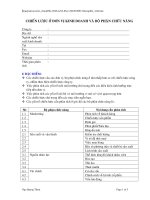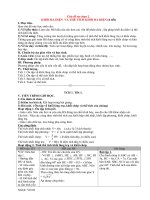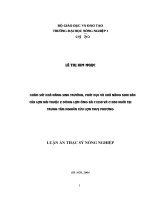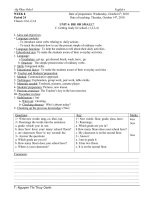C1218 c12
Bạn đang xem bản rút gọn của tài liệu. Xem và tải ngay bản đầy đủ của tài liệu tại đây (29.23 KB, 3 trang )
Designation: C 1218/C 1218M – 99
Standard Test Method for
Water-Soluble Chloride in Mortar and Concrete1
This standard is issued under the fixed designation C 1218/C 1218M; the number immediately following the designation indicates the
year of original adoption or, in the case of revision, the year of last revision. A number in parentheses indicates the year of last
reapproval. A superscript epsilon (e) indicates an editorial change since the last revision or reapproval.
amount, is capable of leading to initiation or acceleration of the
corrosion of metals, such as steel, embedded in or contacting a
cement system such as mortar, grout, or concrete. Thus, its
determination shall be required to evaluate the potential of a
cement system for undergoing such reactions or to investigate
cement systems where such reaction has already occurred.
However, it must be recognized that water-soluble chloride
determined at some particular time in the life of a cement
system is capable of being substantially different than that at
another time; for example, the service environment is capable
of resulting in a higher water-soluble chloride content due to
changes in solubility or a lower one due to leaching.
3.1.1 Test conditions are capable of affecting water-soluble
chloride determinations. Take caution when comparing results
from this test method with those from other test methods.
3.2 Sulfides are known to interfere with the determination of
chloride content. Blast-furnace slag aggregates and cements
contain sulfide sulfur in concentrations that are capable of such
interference and produce erroneously high test results. Treatment with hydrogen peroxide, as discussed in Test Methods
C 114, is used to eliminate such interference.
3.3 There are aggregates that contain chloride that is not
available for corrosion. Such chloride will be detected by use
of this test method.6
1. Scope
1.1 This test method provides procedures for the sampling
and analysis of hydraulic-cement mortar or concrete for
chloride that is water soluble under the conditions of test.
1.2 The text of this standard references notes and footnotes
that provide explanatory information. These notes and footnotes shall not be considered as requirements of this standard.
1.3 The values stated in either SI units or inch-pound units
are to be regarded separately as a standard. Within the text, the
inch-pound units are shown in brackets. The values stated in
each system are not exact equivalents; therefore, each system
shall be used independently of the other.
1.4 This standard does not purport to address all of the
safety concerns, if any, associated with its use. It is the
responsibility of the user of this standard to establish appropriate safety and health practices and determine the applicability of regulatory limitations prior to use.
2. Referenced Documents
2.1 ASTM Standards:
C 42 Test Method for Obtaining and Testing Drilled Cores
and Sawed Beams of Concrete2
C 114 Test Methods for Chemical Analysis of Hydraulic
Cement3
C 670 Practice for Preparing Precision and Bias Statements
for Test Methods for Construction Materials2
C 823 Practice for Examination and Sampling of Hardened
Concrete in Construction2
C 1084 Test Method for Portland-Cement Content of Hardened Hydraulic Concrete2
D 1193 Specification for Reagent Water4
E 11 Specification for Wire-Cloth Sieves for Testing Purposes2
E 832 Specification for Laboratory Filter Papers5
4. Apparatus
4.1 Sampling Equipment:
4.1.1 The apparatus required for obtaining samples by
coring or sawing is described in Test Method C 42.
4.1.2 Use the following apparatus for sampling by drilling
(pulverization):
4.1.2.1 Rotary impact drill and drill or pulverizing bits.
4.1.2.2 Spoon or other suitable means to collect without
contamination pulverized sample material produced by drilling.
4.1.2.3 Sample containers capable of maintaining samples
in an uncontaminated state.
4.2 Sample Processing Apparatus—The apparatus required
for processing samples shall be chosen for its suitability for the
purposes of the investigation, and frequently includes a concrete saw and one or more pulverizers.
3. Significance and Use
3.1 Water-soluble chloride, when present in sufficient
1
This test method is under the jurisdiction of ASTM Committee C-9 on Concrete
and Concrete Aggregates and is the direct responsibility of Subcommittee C09.69 on
Miscellaneous Tests.
Current edition approved July 10, 1999. Published September 1999. Originally
published as C 1218 – 92. Last previous edition C 1218 – 97.
2
Annual Book of ASTM Standards, Vol 04.02.
3
Annual Book of ASTM Standards, Vol 04.01.
4
Annual Book of ASTM Standards, Vol 11.01.
5
Annual Book of ASTM Standards, Vol 14.02.
6
For more information see “The Determination of the Chloride Content of
Concrete,” by Brian B. Hope, John A. Page and John S. Poland, Cement and
Concrete Research, Volume 15, Number 5, Pergamon Press, New York, September
1985, pp. 863–870.
Copyright © ASTM, 100 Barr Harbor Drive, West Conshohocken, PA 19428-2959, United States.
1
C 1218/C 1218M
7. Sample Preparation
7.1 Pulverize the sample so that all the material will pass a
850-µm [No. 20] sieve. Thoroughly blend the material by
transferring it from one glazed paper to another at least ten
times.
4.2.1 Samples more than 25 mm [1 in.] in maximum
dimension shall be reduced in size by use of a jaw crusher or
broken into smaller pieces by hammering carefully to avoid
loss of smaller pieces.
4.2.2 Crush particles less than 25 mm [1 in.] in maximum
dimension using a rotating-puck grinding apparatus, or by
using a disc pulverizer, or mortar and pestle operated to restrict
to negligible levels the loss of fine particles.
4.2.3 The 850-µm [No. 20] sieve shall comply with Specification E 11.
4.3 The apparatus required for the chloride determination
step is given as the reference test method for chloride in Test
Methods C 114.
4.4 Glazed paper to minimize adherence of fine particles for
use as described in 7.1.
8. Procedure
8.1 Select a sample having a mass of approximately 10 g.
Weigh the sample to the nearest 0.01 g and place it into a
250-mL beaker. Add 50 6 1 mL of reagent water meeting
Specification D 1193, cover with a watch glass, bring to a boil
and boil for 5 min. Allow to stand 24 h. Filter by gravity or
suction through a fine-texture, Type II, Class G filter paper of
Specification E 832. Transfer the filtrate to a 250-mL beaker.
Add 3 6 0.1 mL of (1:1) nitric acid and add 3 6 0.1 mL of
hydrogen peroxide (30 % solution) to the filtrate. Cover the
beaker with a watch glass and allow to stand for 1 to 2 min.
Heat the covered beaker rapidly to boiling. Do not allow to boil
for more than a few seconds. Remove from hot plate (Note 4).
Proceed in accordance with the reference test method for
chloride of Test Methods C 114, starting with the procedure
that follows removal of the sample from the hot plate in Test
Methods C 114.
5. Reagents
5.1 The reagents required for the chloride determination are
given in the reference test method for chloride of Test Methods
C 114.
6. Sampling
6.1 Select the sample as required for the purpose of the
investigation (Note 1).
NOTE 4—It is important to keep the beaker covered during heating and
digestion to prevent the loss of chloride by volatilization.
NOTE 1—Because of the small nominal maximum size of the aggregate
in a mortar, pieces of mortar having a mass of at least 10 g will be more
representative of a much larger volume of mortar than would an
equivalently sized sample of concrete. Practice C 823 may be used as a
guide for sampling.
9. Calculation
9.1 Calculate percent chloride by mass of mortar or concrete, by the reference test method for chloride given in Test
Methods C 114.
9.2 Other useful measures of chloride concentration can be
obtained as follows:
9.2.1 For calculating kilograms of chloride per cubic meter
[pounds of chloride per cubic yard] of concrete, multiply
percent chloride by D1/100 or D2/100,
6.1.1 Take concrete cores in accordance with Test Method
C 42 unless otherwise specified (Note 2):
NOTE 2—Concrete cores taken in accordance with Test Method C 42
may be cut longitudinally to provide a 12-mm [1⁄2-in.] thick section
generally representative of the core, or cut laterally into 12-mm [1⁄2-in.]
thick discs representative of the concrete core at various depths. Experience has shown that the cooling water from core cutting will not dissolve
a significant amount of the chloride.
where:
D1 5 oven-dry density as determined in the section on
Concrete Density in Test Method C 1084, kg/m3[lb/
yd3].
D2 5 saturated-surface-dry density as determined in the
section on Concrete Density in Test Method C 1084,
kg/m3[lb/yd3].
The report must state which density is used in the calculation.
9.2.2 For calculating percent chloride by mass of cement,
multiply percent chloride by 100/P,
6.1.2 Powdered concrete obtained by use of a rotary impact
drill is frequently useful in determining chloride concentration
with depth in bridge decks and pavements. When the nominal
maximum coarse aggregate size is 25 mm [1 in.] or more such
samples are unrepresentative. The data must be used with care
or several samples combined. Procedures for this method of
sampling are as follows:
6.1.2.1 Using the rotary impact drill, drill perpendicular to
the concrete surface or parallel to the axis of a cored specimen
to a specified depth or a depth sufficient to obtain a representative sample of at least 20 g of powdered material. To prevent
sample contamination, avoid contact of sample with hands and
other sources of perspiration. Clean all sampling tools prior to
each sampling operation (Note 3). Do not use lubricants during
drilling.
where:
P 5 percent cement by mass in the mortar or concrete, as
known or determined in accordance with Test Method
C 1084.
10. Precision and Bias
10.1 Precision7—This precision statement is based on
samples passing a 600-µm [No. 30] sieve instead of an 850-µm
NOTE 3—Sampling tools may be cleaned with a brush, cloth, ethyl
alcohol rinse, water rinse, or other method that will not contaminate the
sample.
6.1.2.2 Transfer powdered sample into the sample container
using a spoon or other suitable means.
7
Data used to develop this precision statement are available from ASTM
headquarters. Request RR: C9-1003.
2
C 1218/C 1218M
[No. 20] sieve and on a 1 min boil instead of a 5 min boil.
Therefore, results of two properly conducted tests from two
different laboratories on samples of the same material are not
expected to differ by more than 0.0106 %.8 (Note 6).
NOTE 5—It is the opinion of the committee that this difference in
procedure should not significantly influence the precision beyond what is
presented here.
NOTE 6—This precision statement applies to tests of samples prepared
and ground by a single laboratory. Test results of concrete construction
will vary depending upon the method of obtaining the sample and the size
of the sample before it is crushed and reduced to pass the 850-µm [No. 20]
sieve or pulverized.
10.1.1 The single-laboratory standard deviation has been
found to be 0.0013 % chloride by mass of mortar or concrete.8
Therefore, results of two properly conducted tests in the same
laboratory on the same material are not expected to differ by
more than 0.0037 %.
10.1.2 The multilaboratory standard deviation has been
found to be 0.0037 % chloride by mass of mortar or concrete.8
10.2 Bias—The procedure in this test method has no bias
because the value of water-soluble chloride is defined by the
procedure.
11. Keywords
11.1 chloride; chloride content; concrete; mortar; watersoluble chloride
8
These numbers represent, respectively, the (1s) and (d2s) limits as described in
Practice C 670.
The American Society for Testing and Materials takes no position respecting the validity of any patent rights asserted in connection
with any item mentioned in this standard. Users of this standard are expressly advised that determination of the validity of any such
patent rights, and the risk of infringement of such rights, are entirely their own responsibility.
This standard is subject to revision at any time by the responsible technical committee and must be reviewed every five years and
if not revised, either reapproved or withdrawn. Your comments are invited either for revision of this standard or for additional standards
and should be addressed to ASTM Headquarters. Your comments will receive careful consideration at a meeting of the responsible
technical committee, which you may attend. If you feel that your comments have not received a fair hearing you should make your
views known to the ASTM Committee on Standards, 100 Barr Harbor Drive, West Conshohocken, PA 19428.
This standard is copyrighted by ASTM, 100 Barr Harbor Drive, West Conshohocken, PA 19428-2959, United States. Individual
reprints (single or multiple copies) of this standard may be obtained by contacting ASTM at the above address or at 610-832-9585
(phone), 610-832-9555 (fax), or (e-mail); or through the ASTM website ().
3









